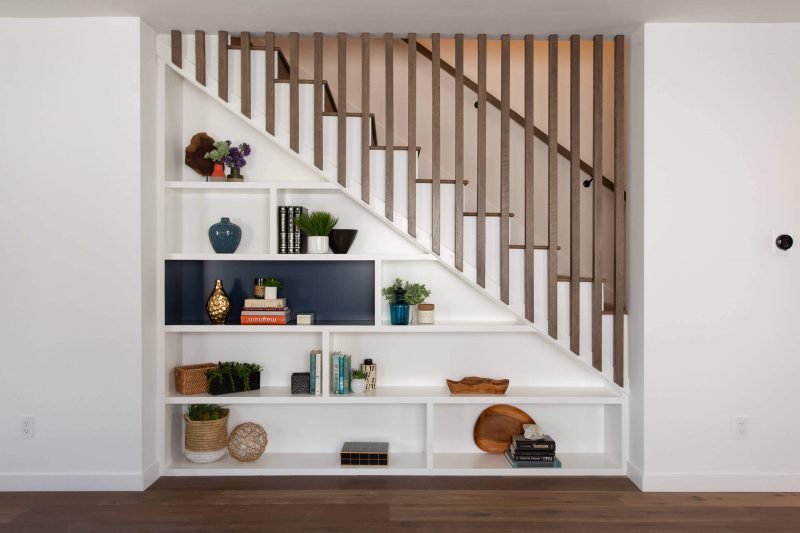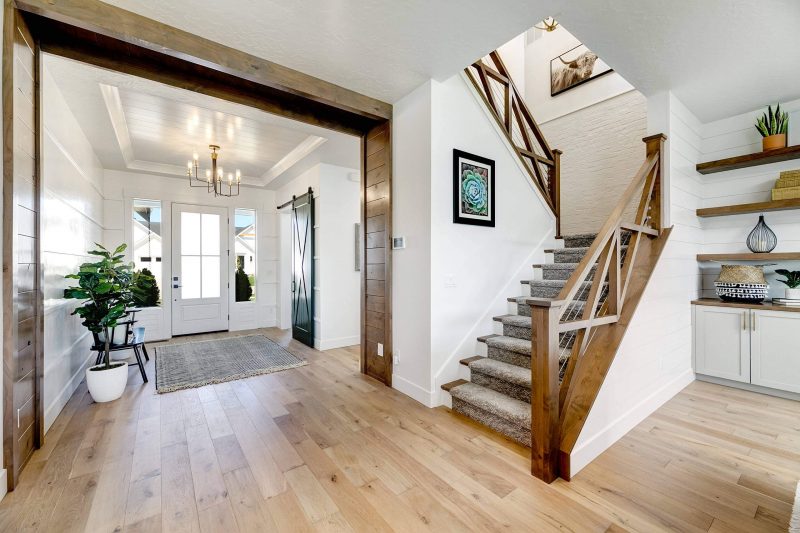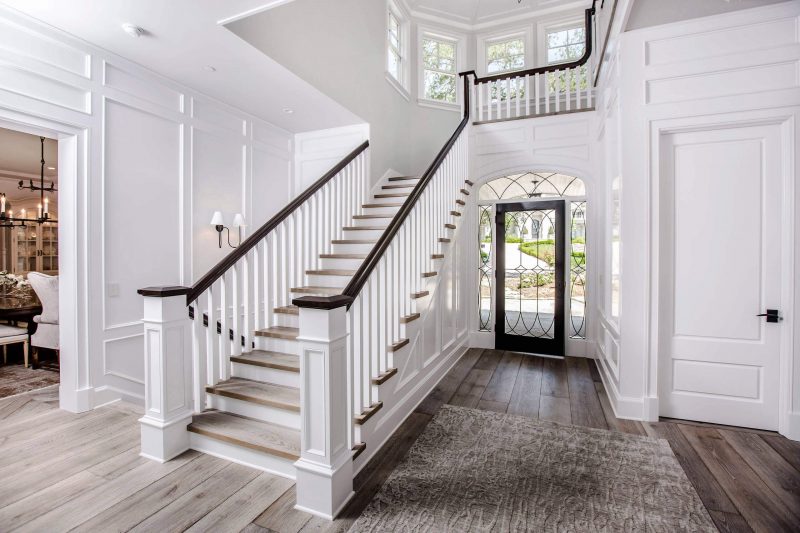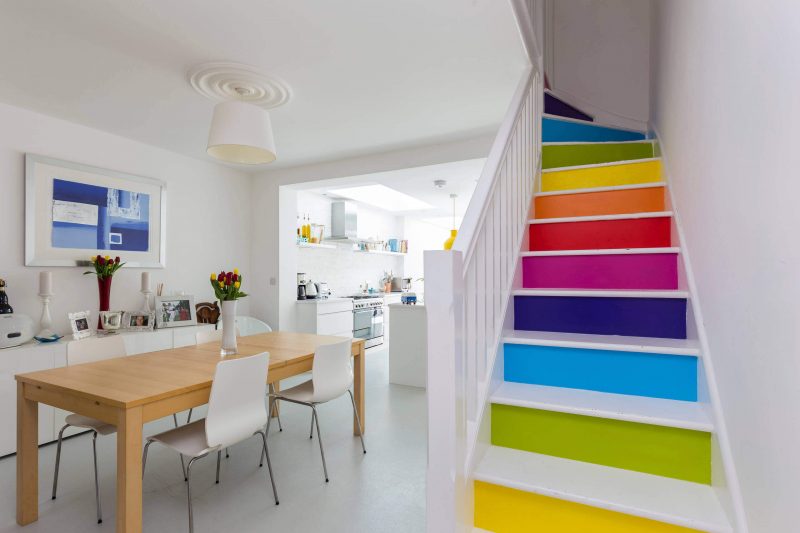Aside from connecting the lower and upper floors, an elegant staircase can also take a home’s design to the next level. But there are countless ways to design this key element in a multistory home.
If you’re looking for staircase designs, this of the top 10 staircase photos in 2022 might help you find your way.
The 10 Most Popular Staircases of 2025
1. Floating Modern Features

The modern Utah staircase that users most saved to their ideabooks this year mixes clean lines with mountain views.
The team at Park City Design Build wanted to emphasize the walls of glass that look out over the surrounding natural scenery in the house, so airy details like the cable railings and custom floating wood stair treads are meant to keep sightlines clear and dramatic.
2. A Reading Rainbow of Risers

Who says you can’t have a little fun with your staircase? Artist and designer Kathryn J. LeMaster gave this Little Rock, Arkansas, stairway a literary look by painting colorful book spines along with the risers. The result? A library’s worth of details to love.
3. Surprise Shelving

Another homemaking smart use of its under-the-stairs space, this Los Angeles-area property, developed by NUMI Home, makes tucked-away storage the star of the show. With clean lines, simple shelf styling, and that bold pop of saturated blue, it’s no wonder the shelves-and-staircase combination was a hit among the Houzz community.
4. Shades of Wood

Solitude Homes’ rustic staircase in this Idaho home features a statement-making wood railing in a slightly richer stain than the wood floors. Combined with the house’s open shelving, a comfy carpet runner, white walls, and other wood accents, the stairs feel immediately inviting.
5. Contemporary Storage

Form and function shine in this Tampa, Florida, staircase. Aside from the striking contemporary railing made by local fabricator Vasquez Custom Metals, the staircase stands out with its clever storage spaces.
General contractor Robert H. Delafield and other design pros made the most of an often-overlooked space with natural wood cubbies that are playful and practical.
6. A Touch of Colorful Tile

By decking these stair risers in colorful patterned tile, the team at Timeless Interiors incorporated a fun, unexpected component to an otherwise refined space in New York. Alongside the graceful curve of the staircase, the rich dark-wood railing, and the ornate metalwork, the tile strikes a balance between laid back and luxe.
7. Transitional Charm

With a complimentary old-fashioned rocking chair in the background and neat, geometric metalwork, this staircase doesn’t stick to just one style. Wood accents, added by custom furniture maker Thos. Moser, introduce more character.
8. Warm and Welcoming

A medium-warm wood set against bright white in this Salt Lake City home designed by The Fox Group establishes an immediate sense of cozy farmhouse charm. Overhead, a more contemporary gold light fixture updates the look and adds another element of warmth.
9. Bright White and Wood

Embellished woodwork and glass, abundant natural light, and a substantial traditional staircase come together in this Los Angeles-area home to create a sophisticated entryway.
Beneath the stairs, wide planks of ashy European oak from Pacific Hardwood Flooring keeps the room looking fresh.
10. Classic Character

The newel post that anchors the staircase in this Vermont farmhouse was custom-made by Birdseye. Paired with space’s wide-plank floors, white shiplap walls, and warm wood treads, the vintage-style piece sets the tone as homespun but polished.
5 Ways to Beautify Your Staircase With Paint
Painting your staircase is probably one of the most unexpected ways to breathe new life into space.
It’s an unusual touch that can energize and add character to your home. Plus, your stairs are hardworking and deserve a second look.
Here are five ways paint can take your stairs from dull to dazzling.
1. Color the stair treads.

This staircase leads to a fourth-story game room for kids, and the two colors of blue on the stair treads create a fun path to follow. By painting just the treads and leaving the risers white, the effect is colorful but not busy.

Here’s another look at the same staircase, viewed from the top. The two colors of blue make a beautiful alternating pattern that is an attractive design feature.
2. Make a rainbow on your risers.

Or you can paint just the risers. This staircase adds a colorful, fun design feature to a room that is contemporary, streamlined, and mostly white. (Another rainbow touch shows up on the London patio’s outdoor sofa.)
If you decide to create a rainbow effect in your home, I recommend that you keep all your colors within the same tint (level of lightness) or shade (level of darkness or richness) to ensure a cohesive look. And make sure all the paints you use have the same finish.
3. Leave the handrail unpainted.

What this staircase lacks in color it makes up for in style. The all-white treads, risers, and stringer, or outside wall of the staircase, work with the white balusters to make a dramatic backdrop that lets the wooden handrail stand out. It’s a clever approach since the handrail is a real-life version of the material depicted in the wallpaper: the woods.
Wallpaper: Woods, Cole & Son

Here’s another version of the same principle but with a staircase that has a contemporary design. The staircase’s treads and stringers are painted black, while the handrail stays natural wood. Here, the effect is that both the stairs and the handrail stand out.
4. Paint a runner.

This staircase in a London home features a wood strip down the center of the staircase, with white painted on both sides of the staircase as well as the bottom riser.
The paint job creates an effect of a natural wood runner making its way down the stairs. It’s a clever idea that has some humor to it — since runners are typically made from textiles, a wood stair runner would be an unexpected feature indeed.

Here’s another take on the painted runner. This staircase, in a home in the United Kingdom, also has white sides, but the center is painted a soft gray, and this runner is much wider. This is a more subtle effect and works with the gentle color scheme of this white, gray, and wood staircase and landing area. The approach also fits the style of this elegant home with a neutral palette.

Try a color trio. For a more dramatic effect, play with color. This bold color combination of black, white, and green paint makes this staircase a statement feature. You will notice the color trio is also carried up to the wall with the use of green picture frames and black-and-white photography.
The vibrant Kelly green is also repeated throughout the residence with decorative accents like a bold green porter’s chair in the entry and green trellis-patterned drapery in the living room.
When considering a color trio for your staircase, think about how the colors will work with the connecting rooms. This will keep it from feeling like an afterthought.
5. Add a touch of whimsy with numbers.

Painting your stairs using numbered stencils is an easy way to give your stairs a cheeky twist. Without the numbered steps, this staircase would definitely feel less playful and interesting. You can choose to line up your numbers on either side of your stairs or down the middle.
Be sure to measure as you stencil each step to ensure the numbers line up. I recommend that you start from the top and work your way down to avoid any potential mishaps with wet paint.
An Expert Guide to Safe and Stylish Staircases
A staircase is a simple and elegant way for people to move between floors. The layout, design, and execution by the builder all play a part in determining how safely and comfortably a stair accomplishes this task.
Lingo to know:
Tread: The horizontal board you walk on, usually at least 1 inch thick
Riser: The vertical board between treads
Newel: The post to which the railing is attached
Runner: A carpet with woven edges that covers the middle of the treads and risers
Stringer: The supporting structure of the stair

Safety First
The horizontal distance from the front to the back of the tread is called the run, and the vertical distance is the rise. As you will have noticed from the staircases you’ve walked on, the rise and run can vary.
Rise-to-run ratio. The total of the rise and run should add up to 17 inches. Practically speaking, this means that as the run gets shorter, the rise should get steeper for the stair to feel comfortable as you walk. There are limits, of course. A rise of more than 8¼ inches is going to be too steep for many people.

Consistency. Even more important, the ratio of rising to run must be consistent. If you stumble or trip on a staircase, it is probably due to a tread or riser that is not the same size as the others. Our bodies get in a rhythm when climbing or descending, and even an inch of difference can be enough to throw us off.
If you are thinking about adding flooring on top of existing flooring where it meets a staircase, keep this in mind. The treads may need to be adjusted as well.
Another thing that makes a stair comfortable to use is a tread overhang. Although some modern staircases omit this detail, an overhang will keep heels from scuffing risers on the way down and help you find your footing on the way up.

Another modern-style detail is to omit the riser entirely. You’ll still have a rise, of course (you wouldn’t get upstairs without it), but it’s just empty space instead of aboard. Building a stair this way means you won’t be able to hide the supporting structure of the stair: the stringer. In the stair pictured here, the stringer is made of steel.
Most wooden staircases have two or three wooden stringers, angled lumber with sawtooth cuts where the treads and risers attach. For safety, a stair that doesn’t have a riser should have a thicker tread, like the one shown. This reduces the space between treads.
Most codes will not permit an open riser unless the opening is 4 inches or less. Although you’ll see stairs that don’t follow this rule, a child could crawl through a larger space, so for safety’s sake, build to code.

Ceiling height. The distance from the highest tread below a ceiling should be at least 80 inches, or 6 feet, 8 inches. As a 6-foot-3-inch man who lives in Philadelphia and spends a lot of time in historic homes, I can tell you that this rule wasn’t regularly followed in the time before building codes. Don’t make the same mistake.
On the way up, people will bump their heads if the ceiling is too low. On the way down, it’s hard to judge ceiling height, so people will duck if it looks too close. Give people plenty of room whenever possible. A stair is a dangerous place for a fall, and the codes governing stairs are designed to prevent just that.

Stair Style
Although the tips above are not enough to teach you how to build a stair (that’s one of the most complicated things a carpenter does), they will help you understand how and why they are laid out the way they are.
Now let’s talk about the way stairs look. After all, there is beauty in the function of a staircase — a well-designed stair can be one of the most stunning forms in your house.
A staircase has many parts, and since most are made of wood, one of the questions you’ll face is whether to add a clear coat or paint it. Traditional stairs often have a combination of both.
To paint or not to paint? My advice is to avoid paint on treads and banisters. These get the most wear, and paint shows wear more readily. If the treads have been painted before, or if you want that look, we’ve had good success with Fine Paints of Europe.

Balusters are the jewelry of a staircase. Unlike your favorite ring or necklace, though, you’ll often need more than 30 matching balusters to make a set.
This means the cost of a fancy turned baluster can add up quickly, so consider salvaged balusters. Architectural salvage shops often rescue a whole set from a Dumpster, and you can purchase a style that is not readily available today.
The photo here is of balusters at Re-Store, one of my go-to salvage places in Philadelphia. Often, older styles were thicker and made of hardwoods, unlike the softwood balusters you generally find today.
If they are coated with many layers of paint, find a local paint stripper who can dip them for you. This is a safer, quicker, and more environmentally friendly way to strip paint than doing it yourself.

Here we see two elements that can dress up a stair. One looks functional but isn’t, and one looks decorative but performs an important function.
On the side of the stringer, below the tread, are carved tread brackets. Though they look like they’re holding up the treads, they are applied moldings. If your stairs do not have tread brackets and you want to add some flair, gluing or nailing on brackets is a good DIY project.
The wainscoting on the walls is a nice way to follow the line of the stairs on the wall, mimicking the angle of the railing. Because stairs get so much traffic, wainscoting is a good way to protect the walls. Wood paneling will hold up much better than drywall here.

Newel posts are another stair part you may be able to find salvaged. Salvaged or new, the newel anchors the railing. Any time you have a building element that is fastened to a wall only at one end of the span, you have the potential for wobble.
Some stair railings go up several floors in a continuous loop before they reach a wall. A firmly anchored newel post is critical to making sure your railing is secure.
If your existing newel post is wobbly, you can buy a kit from the hardware store that contains angle brackets to anchor it to the floor, and wood trim with space routed out so that it hides the brackets. Once it’s painted or stained, it will look like a part of the post.
If the post is on the first floor and you have a basement, you can hide the fasteners by coming up from below with lag screws.

If you can’t find a solid newel post you like, or you want something more massive, a box newel can be made out of stock boards and applied moldings, creating a post like the three pictured here. Because the interior framing will be covered up by the finish carpentry, it is easier to anchor this type of post.
Also, take note of the recessed step lights along the wall. We started this guidebook talking about safety. Good lighting is critical, and lighting focused on the treads allows you to illuminate the stairs safely without overlighting the rest of the space. The runner pictured here also protects the stairs and makes them less slippery, reducing falls.
Safety first, safety last. Happy climbing!
Source: houzz.com/magazine


You must be logged in to post a comment.